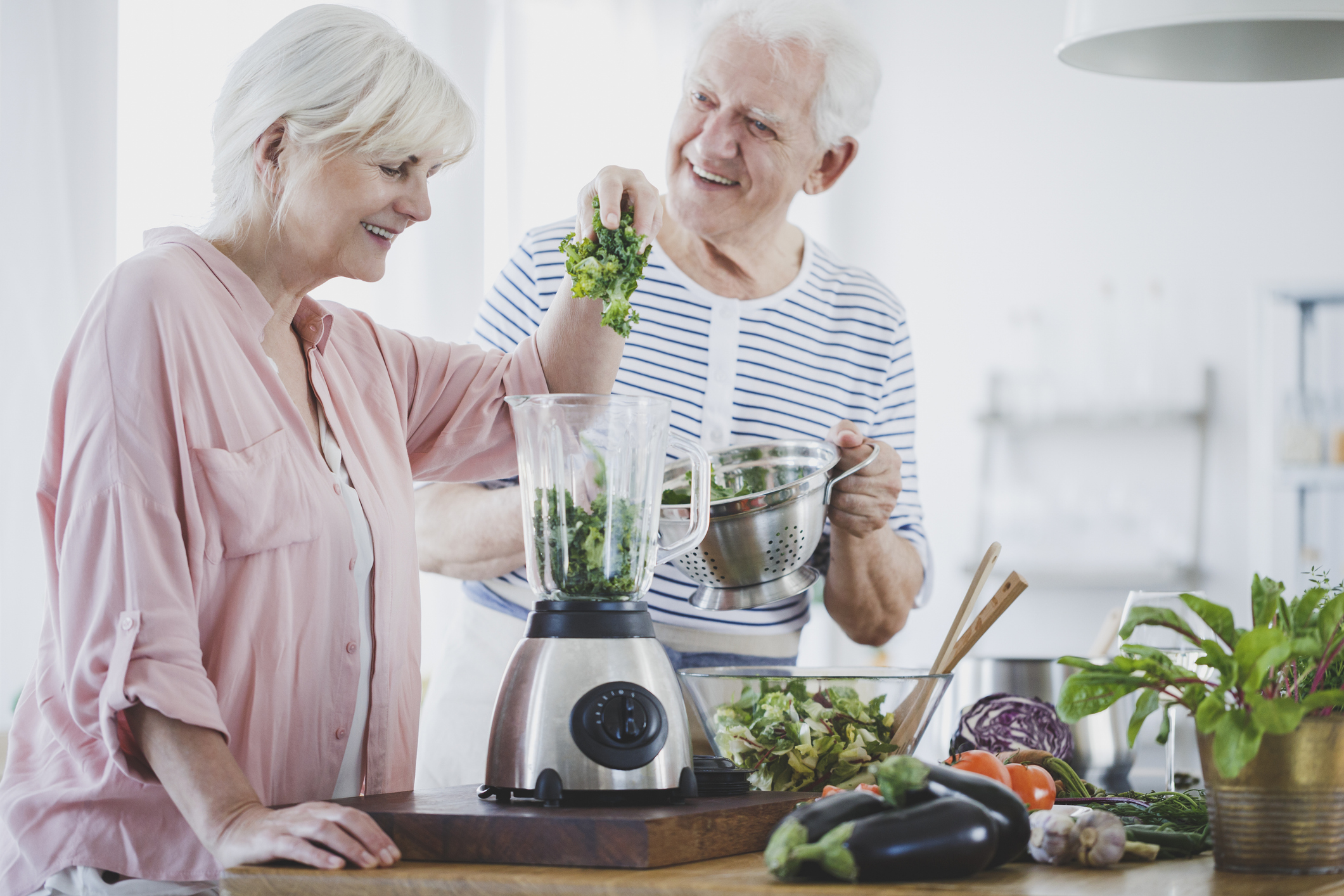Get Easy Health Digest™ in your inbox and don’t miss a thing when you subscribe today. Plus, get the free bonus report, Mother Nature’s Tips, Tricks and Remedies for Cholesterol, Blood Pressure & Blood Sugar as my way of saying welcome to the community!
Can juicing be good for you at all?

It depends on how you get your juice.
The best way to get your nutrients from fruits and vegetables is to eat them whole, fresh, organic, and often.
In the end, you’ll be healthier for it, and less light in your wallet. Two to four pounds of fruits and vegetables is a LOT (the amount needed for one of those store-bought 16-oz juices I wrote about last week) — and will last you more than a few days if eaten raw and in their natural form.
I do “technically” juice. But I don’t drink or buy the cold-pressed, or any other commercially made store-bought juices. Nor do I use our juicer at home that has sat lonely and untouched for quite a while now. Because all that fibrous by-product of juicing that you throw in the trash? Well, that’s all the natural fiber left once the juice is extracted — and you need it.
Here’s how I do it — properly.
I use a blender, not a juicer. The Magic Bullet is awesome. You can put in whole bits of fruit or vegetables and it will turn it into liquid. You use a tiny relative amount of the fruits and vegetables you would otherwise use — and you get all the benefits of the fiber that is fully retained in the liquid. Fill it up half way with water and add your chopped up vegetables and other ingredients (like raw ginger, almonds, turmeric, beets, etc). Crank it up and drink it straight away. All of the health benefits of vegetables — and none of the waste. It’s that simple. Too me it’s just the same as eating raw vegetables — kind of like drinking adult “baby food” (see below my “go-to” juicing recipe).
Some special juicing tips for athletes
For all you athletes out there it’s important to know the best way to juice to reap the most health benefits and avoid getting fat (yes you can get fat from juices). So here are some important tips on how to juice at home.
Use a blender not a juicer (see above).
Don’t use so much fruit.
One of the biggest mistakes people make when juicing is to use too much fruit.
When you juice fruit, you are left with a high concentration of fructose sugar. Since liquid is digested much faster than solids (as in eating an apple or pear), this high concentration of fructose hits the body and your liver is charged with processing it. The fructose is transformed into free fatty acids, very low-density lipoprotein cholesterol, and triglycerides, which are stored mainly as fat.
In fact, one third of fructose calories consumed are stored as fat. So if there are 180 calories of fructose in your juice, 120 of them are stored as fat. In addition, the created fatty acids can gather in your liver and skeletal muscles and eventually lead to insulin resistance, which then can progress to type 2 diabetes. Fructose also converts to a glycerol that is used to transform free fatty acids into triglycerides.
Also, when your liver is metabolizing fructose, it creates toxins and waste material, including uric acid, which can heighten blood pressure and cause gout. Another problem with all that fructose is that is goes mainly toward replacing glycogen in the liver rather than muscle. So unless you are in a calorie-deficient mode, the fructose readies your body to store fat rather than helping you out in the muscle department in the gym, on your bike, or on the road.
Don’t use just any juicing recipe
There are lots of juicing books out there as well as websites offering scores of recipes. However, most of them don’t focus on vegetables and alkalinity, and the impact on athletes.
If you exercise moderately and especially if you’re an intense athlete or exerciser, then lactic acid, pyruvate acid, and carbon dioxide accumulate as you work your muscles. When muscles become acidic, they become fatigued. During long training or exercise sessions, the rise in acidity reduces the amount of time you can exercise and lengthens your recovery time.
What you want is a more alkaline environment so you can avoid the buildup of lactic and other acids that can hinder performance. A healthy alkaline balance raises the pH of your cells and tissues and neutralizes acids. However, most juicing recipes use fruits that do not create alkalinity in the body.
The best alkalizing fruits are lemons, watermelon, cantaloupe, limes, and mango. Alkalizing vegetables include broccoli, beets, cabbage, cauliflower, and Brussels sprouts. The fruits and vegetables you want to avoid when juicing are chard, corn, cranberries, dates, figs, green peas, plums, pomegranates, string beans, tomatoes, and zucchini. These are classified as acidic to varying degrees.
Eating alkaline foods can help athletes maintain health and performance, aid recovery, and avoid stress on the body associated with consuming too many acidic foods.
Don’t forget fats and proteins
Athletes need healthy fat and protein, and without sufficient amounts of each they can expect lean muscle tissue breakdown, muscle fatigue, accumulation of fatty tissue, lack of energy, and poor athletic performance. Yet you don’t see sources of healthy fats or protein in most juice recipes. In fact, some commercial juices and juice recipes are quick to point out that they are low-fat or fat-free.
Yet you need fat for your body to transport the fat-soluble vitamins (A, D, E, and K) that may be provided by the juice. Without the fat, you won’t reap the benefits of these vitamins, which are involved with bone and nervous system health, hormone production, cell membrane formation, and regulation of heart rate and blood pressure, while also providing a slow-release form of energy.
Some of the prime fat choices are chia seeds, pumpkin seeds, hemp seeds, extra virgin olive oil, and raw, unprocessed coconut oil. Generally, about one ounce of the seeds or 1 tablespoon of the oils is recommended. You can also add almonds or walnuts for additional fats. They blend up with no problem when using the Magic Bullet.
As far as protein is concerned, I recommend you use a serving of an organic vegan protein powder. Stay away from whey and soy protein powders.
Add a performance booster
Numerous studies have shown that raw beet juice can enhance exercise performance. Beets are also especially important for heart and sexual health. So you might want to consider adding raw beets to your juice recipe like I always do. You may also want to add a serving of this stuff.
Enjoy juice with other healthy foods
Adding foods that contain fiber, healthy fats, and/or protein will not only round out the meal nutritionally, but will also slow the absorption of sugars from the juice. When it comes to digesting sugar, slower is generally better. Nuts or nut butter, whole grains, Greek yogurt, avocado, olive oil, fish, and/or whole fruits and vegetables are all be good complements to fresh juice.
So what does all that look like in my Magic Bullet? Here’s my go-to juice:
- 2-3 cups water;
- Serving of chocolate organic vegan protein powder;
- Sprinkle of organic cayenne pepper;
- 5-10 almonds;
- 5 walnuts;
- 2 tablespoons of raw coconut oil;
- ½ teaspoon organic ceremonial matcha green tea powder;
- Handful of kale;
- Handful of spinach
- ½ raw beet;
- Sprinkle of Chaga mushroom powder;
- ½ inch piece of raw turmeric; and
- ½ inch piece of raw, peeled ginger.
There you have it, my manifesto on cold-pressed juices and juices you make at home. The bottom line is, choose whole, natural, organic, fresh fruits and vegetables over juices. However, if you like to have an alternative, especially when you are training hard, then make your own juices at home following the suggestions provided here. To your health!












